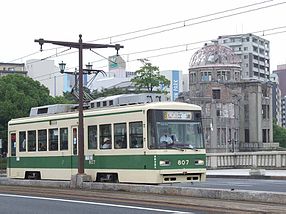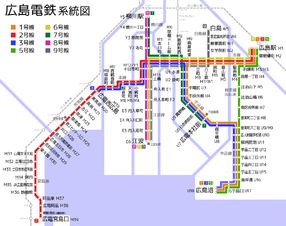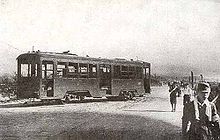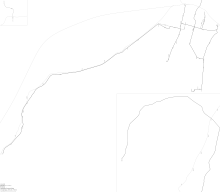Hiroshima Tram
| Hiroshima Tram | |
|---|---|
| Old cars in front of the atomic bomb memorial | |
| Basic information | |
| Country | Japan |
| city | Hiroshima |
| opening | 1912 |
| operator | Hiroshima Dentetsu KK |
| Infrastructure | |
| Route length | 19 km + 16.1 km (railway line) |
| Gauge | 1435 mm ( standard gauge ) |
| Power system | 600 V = overhead line |
| Operating mode | Bidirectional operation |

The Hiroshima Tram is the tram network in Hiroshima on the island of Honshū in Japan . It is operated by the private company Hiroshima Dentetsu ( Japanese 広 島 電 鉄 ), Hiroden for short ( 広 電 ). In terms of network length, it is the largest tram network currently in operation in Japan.
stretch
| Surname | length | Lines | Routing | Stops | Duration from start to finish |
|---|---|---|---|---|---|
| Honsen ( 本 線 ) | 5.5 | 1, 2, 3, 5, 6, 7, 8 | Hiroshima Train Station ( 広 島 駅 ) - Hiroden Nishi-Hiroshima ( 広 電 西 広 島 ) | 20th | 32 |
| Ujina-sen ( 宇 品 線 ) | 5.7 | 1, 3, 5, 7 | Hiroshima Port ( 広 島 港 ) - Kamiyachō-Higashi / Kamiyachō-Nishi ( 紙 屋 町 東 / 紙 屋 町 西 ) | 19th | 30th |
| Eba-sen ( 江波 線 ) | 2.6 | 6, 8 | Eba ( 江波 ) - Dobashi ( 土橋 ) | 7th | 13 |
| Hakushima-sen ( 白 島 線 ) | 1.2 | 9 | Hakushima ( 白 島 ) - Hatchōbori ( 八 丁 堀 ) | 4th | 7th |
| Minami-sen ( 皆 実 線 ) | 2.5 | 5 | Minamimachi 6-chōme ( 皆 実 町 六 丁目 ) - Matobachō ( 的 場 町 ) | 7th | 11 |
| Yokogawa-sen ( 横 川 線 ) | 1.4 | 7, 8 | Yokogawa Station ( 横 川 駅 ) - Tōkaichimachi ( 十 日 市 町 ) | 5 | 6th |
There are also the Miyajima-sen ( 宮 島 線 ) consisting of 21 stops from Hiroden Miyajima-guchi ( 広 電 宮 島 口 ) to Hiroden Nishi-Hiroshima ( 広 電 西 広 島 ) in the neighboring city of Hatsukaichi on a total length of 16.1 km. However, it is legally classified as a railway line that runs separately from road traffic and thus has a light rail character.
Lines
| No. | stretch | Routing / important stops | Stops | Duration [min] |
|---|---|---|---|---|
| 1 | Honsen, Ujina | Hiroshima Train Station - Hatchobori - Kamiyacho-Higashi - Hiroshima Port | 27 | 44 |
| 2 | Honsen, Miyajima | Hiroshima Station - Hatchōbori - Kamiyachō - Tōkaichimachi - Hiroden Nishi-Hiroshima (Koi) - Hiroden Miyajima-guchi | 20 (Honsen) + 20 (Miyajima) |
32 (Honsen) + 31 (Miyajima) |
| 3 | Ujina, Honsen | Hiroshima Port - Kamiyachō-Nishi - Tōkaichimachi - Hiroden Nishi-Hiroshima (Koi) | 29 | 48 |
| 5 | Honsen, Minami, Ujina | Hiroshima Railway Station - Hijiyama-shita ( 比 治 山下 ) - Hiroshima Port | 18th | 28 |
| 6th | Honsen, Eba | Hiroshima Station - Hatchōbori - Kamiyachō - Tōkaichimachi - Eba | 20th | 35 |
| 7th | Ujina, Honsen, Yokogawa | Hiroden Honsha-mae ( 広 電 本社 前 ) - Kamiyachō-Nishi - Tōkaichimachi - Yokogawa | 15th | 25th |
| 8th | Eba, Honsen, Yokogawa | Eba - Tōkaichimachi - Yokogawa | 12 | 21st |
| 9 | Hakushima | Hatchobori - Hakushima | 5 | 7th |
history
The operation was opened in 1912 with the Honsen, Hakushima-sen and the Ujina-sen to Miyuki-bashi (御 幸 橋), the latter expanded to the port in 1915. The Yokogawa-sen followed in 1917 and the Minami- and Eba-sen only in 1943/44 (with simultaneous routing in the transition to the Honsen). The Miyajima-sen was built starting from the Nishi-Hiroshima station from 1922 to 1931; continuous operation with the tram was not started until 1958. The network was severely damaged by the atomic bomb being dropped on Hiroshima on August 6, 1945, but the first tram was running again after just three days and operations were completely rebuilt. In addition to realignments on the western Honsen and Hakushima-sen, the post-war period brought smaller expansions of the Eba-sen (1954) and Ujina-sen (1967). The Ujina-sen experienced a last small expansion in 2003.
vehicles
Apart from a few parade and special cars, 61 high-floor single cars and 37 three-part high-floor articulated multiple units (“Green Liner”) from various series are available for operation. Since 1999 Siemens has also supplied twelve five-part Combino (“Green Mover”) and a Japanese consortium ten five (“Green Mover max”) and eight three-part (“Green Mover Lex” / “Piccolo” / “Piccola”) low-floor articulated multiple units.
The variety of types and the age of some vehicles led to the company's reputation as a rolling tram museum (動 く 電車 の 博物館ugoku densha no hakubutsukan ); Meanwhile, however, a much more modern and more uniform picture emerges.
From 1981, two GT8 cars from Dortmund drove in Hiroshima, initially in regular service, later mainly for special trips. One car (Tw 77) was scrapped in 2006, the other (Tw 76) was set up as a cafe car next to the Hiroden headquarters in 2012. The car is now in the department store "The Outlets" in Hiroshima. The superstructure Tw 238 came from Hanover in 1988 and is occasionally used on lines 8 and 9 (mainly in winter due to the lack of air conditioning).
Web links
- Hiroden website (Japanese, English)
- Info at eurotram.com (French)
Remarks
- ↑ If the railway line to Miyajimaguchi is not taken into account, it is only the second largest after the Kōchi tram .






